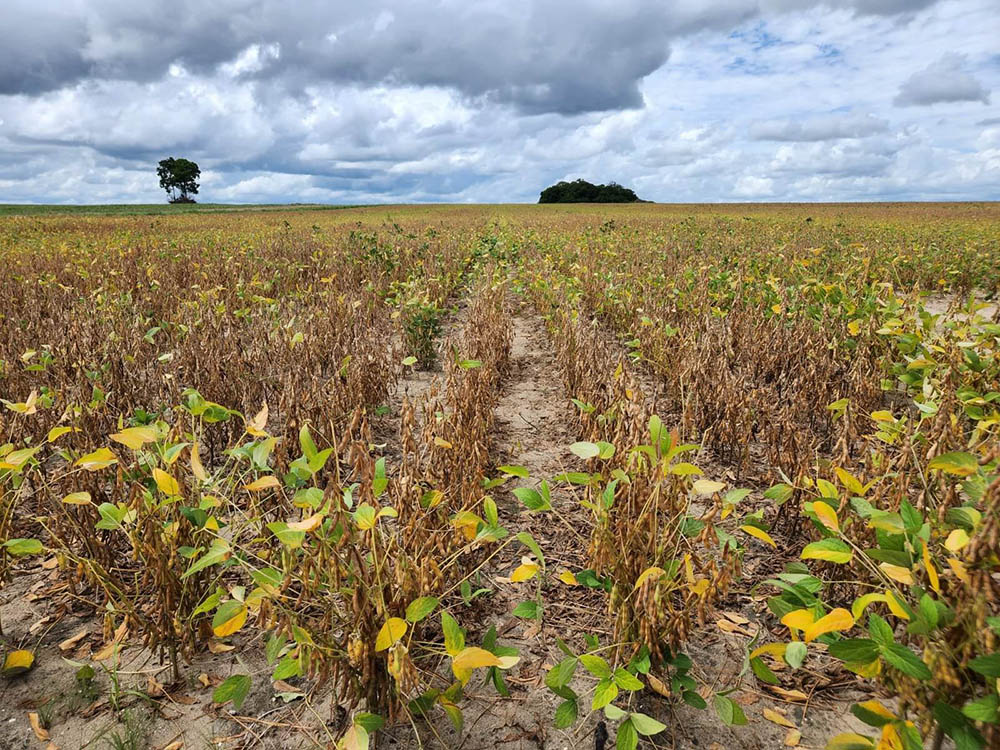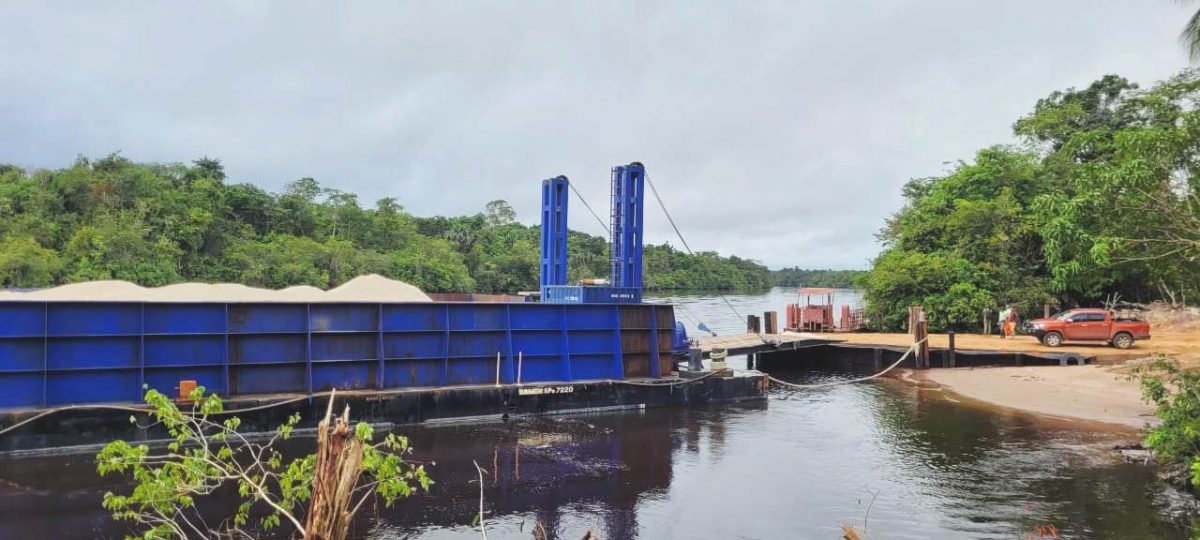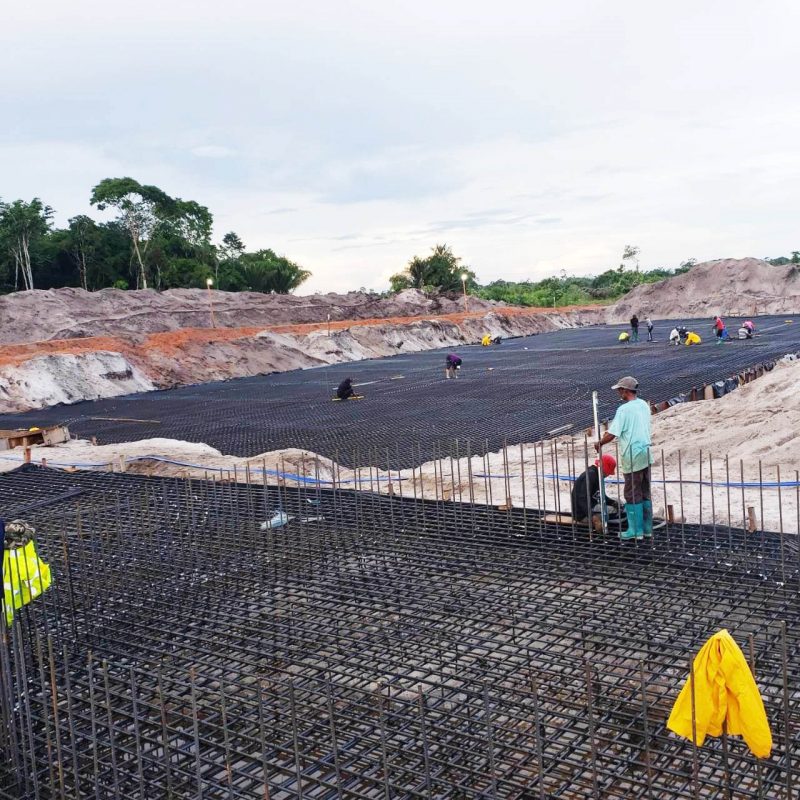As its second soya bean crop for this year is currently being planted and government forges ahead with infrastructural support works at the Tacama Gold mega-farm in the Intermediate Savannahs, the consortium spearheading the project has confirmed plans for two crops per year, given better than projected yields.
And as it maps strategies for its investment—pegged at some $570 million to date—it anticipates having ample livestock feed supply to the Caricom regions from over 15,000 acres of land that would be utilized by 2027.
“We did quite well because this is all virgin soils. Right now, everything looks promising because one of the fields did three tonnes per hectare because we projected less, because this was a field that nothing was ever planted on before, ever. We went and put in the seeds and the area did magic,” Director of Tacama Gold David Fernandes told Stabroek News in an interview last week as he gave an update on the project.
“So we basically used parameters that are global to be able to calculate the lands we would need to produce this [the amount of crop]. Now if you note here, we were only to do one crop per year, but when we did the trials at Dubulay Farms, we figured out that we could actually do two crops a year. We are going to be doing that because we reaped one crop and have started planting the other already. That [planting] process will end next week,” he added.
He is optimistic that “if the man upstairs [God] keeps blessing us, we will get better and better after every crop.”
Fernandes explained that the group had asked government for 85,000 acres of land to work but was given 27,000 to use, so that the venture could be assessed before additional lands are given. “We have to do a good job before they would, obviously, look to give us more, which is not a problem,” he said.
However, setbacks with delivery of limestone to neutralise the acidic soil in the Region 10 area being used saw planting of only 450 acres as compared to the 1,000 that they had earmarked.
But the company projects that it can get can get up to 2.2 tonnes of crop per hectare, as the best fields did over three tonnes per hectare this year .
“Our next phase we will plant 1000 acres and are doing so now as we speak. Then next year we will start going to 2,500 acres …and so on. We will rapidly expand and hope to get to the 6,000 acres…then 15000 acres. Our goal is to get there fastest,” he said, while pointing out that the goal target is to begin exporting significant amounts through the Caricom Single Market and Economy by 2027 “if not before.”
No till as much as possible
Fernandes noted that in cultivating the crop the group has decided to minimize the use of tilling. ”Most of the places in the world are depleting the organic matter in the soil and causing it to become a desert. We won’t do that. The soils we went and work with, because we don’t want to be chopping our jungles down, we took the worst soils that was available; Savannah Soils. So we have to increase the organic matter in the soil and make it more fertile. Hence are now using no or little till methods,” Fernandes said.
“For the second crop, you just shred the crops when you harvest, on top of it and leave it there to become like a mulch; like organic matter, and we will plant on top of that. You will find that after a year or two, you will see the area not as sandy anymore, because that matter will now make the soil quality better and better. We plan to use no till as much as possible,” he added.
The large-scale trial cultivation of corn and soya bean by the private investors was announced in 2021 as they stated it was being explored as a means to safeguard the country’s livestock feed supply.
Spearheaded by a consortium of businesses in the livestock production industry that includes Guyana Stockfeeds Ltd, Royal Chicken, Edun Farms, SBM Wood, Dubulay Ranch, NF Agriculture, and Bounty Farm Ltd, of which Fernandes is an executive, the trials began in 2021 and 250 acres of lands owned by Alex Mendes of Dubulay Ranch.
He reflected on when the group of business persons were asked if they wanted to invest.
“The president when he asked if we wanted to go in this direction…I remembered Richard Branson who said when an opportunity is given, say yes because it may never come again so I jumped at it. What surprised everyone is that we planted six months after that and did it in the middle of the floods and in the height of COVID,” he expressed.
For a project that sees investments of over half a billion dollars from the consortium, Fernandes said that he was not fearful in investing his share because with investments come risks.
Fernandes had in May of this year told this newspaper that the trials found that it was “very feasible” to not only plant the crops here but that two, instead of one crop was possible. It is against this background that work commenced at Tacama Gold Farms, a name given because of the colour of the corn and soya grains that will be planted there.
Giving a detailed timeline on project developments, Fernandes explained from a PowerPoint overview the highpoints and challenges to date.
“The project started this year in March, when we got the new pieces of land given to our company by the government. That was done in March and then in April we started the process of constructing everything at the Marshall yard and so on. The company was started [incorporated] on the 15th of March 2022. It’s basically a partnership of four Guyanese companies, three of which are feed manufacturers and one is a Timber processing company,” he informed.
He said that as per the farm, the group “based what we wanted to produce for national production based on the on the total broiler or livestock feeds consumed locally”.
He continued, “and that was 60%, either rice or corn, which is 68,000 tonnes per year, and 34,000 tonnes of soya bean. Sixty percent of feed consumed in feeds locally is either corn or rice or a combination of the two. That amounts to the 68,000 tonnes per year and 30% of feed produced is soya bean.”
Setback
The first shipment of limestone came on June 18 and due to the impending rainy season here, he said it “was a bit late because it was in the middle of the rainy season already. So that put us on a little bit of pressure.”
However, the setback, which delayed planting, did not stop the company. “We had wanted to be planting during this time but we were waiting for the limestone to come so the biggest limitation was for us to plant all of the lands we projected. It did come and we did the best we could after that. We had to plough twice because it was two sets of limestone at two tonnes per acre,” he explained while showing how that process is conducted. The limestone is set on the grass and ploughed with it at a deep level. After that process is finished, another portion is set and ploughed six inches deep. After that, a final chip and final leveling is done before the planting of the seeds commences.
Fernandes related that they began planting on July 18 and were finished on the 29th of the same month. They would only plant 450 acres.
“We had more seed and more fertilizer to plant double that but we couldn’t do it because we didn’t have the limestone in time and we would have run out of time if we planted later,” he explained before reminding that the limestone neutralizes the soil because the soil is very acidic. “The soil is between 4.1 ph to 4.7 ph and we had to get up closer to 6 ph. So all the soils in Guyana are quite acidic, 4.1 to 4.7 ph,” he explained.
The limestone was sourced from the Dominican Republic and is dolomitic, which means it has between 17 and 20 per cent of magnesium and he had said that factor is very important. “It is important because the soils in this region have a lot of aluminum in it. We mine bauxite in that region. But this ore is toxic to the plant. The magnesium will neutralise that and it will neutralise the aluminum toxicity,” he explained.
Fernandes had also explained with the roadwork infrastructure unable to accommodate the weight of items needed currently, the Berbice River is being used as the main medium of transport and that way has been working out “great”.
“We use the river. From the first trial, we knew that coming by road would not be as cost efficient as using the river. So the limestone, the grain, will go by river. The fuel will come by road as the area’s roads are being developed. It is a bit more comfortable to drive in. To get to Linden is two hours so for critical stuff we will use the road. But large volume stuff will go by river,” he said.
“Having it so close to the Berbice River means we have a real great opportunity to be able to not only supply the Guyana market but keep heading north out of the mouth of Berbice,” he added.
But now, he pointed out, with major roadwork underway, getting into the area by vehicle is not as difficult as before, although the river will be used for transporting weighty items to the location.
“They did a good job of fixing the road. The Brazilian company that did the 80 kilometers. And then the other road which started where they stopped that 19 kilometer to the river began and the local guy, a fellow named Lewis, he did an excellent job also. On the 26th of June, we had this deplorable trail; trucks were turning over on the road, being stuck….but look at that same stretch now,” he said pointing to photographs he took for comparison.
And when they reaped about 115 days to 120 days after planting, the drying facility government has set up in the area was not yet completed, so they had use a portable dryer to dry the crops. “We had to get them from 17% to 14% moisture before we transported it to the feed mills,” he said while pointed out that the harvest from the first crop weighed about 115 [tonnes] to about 120 [tonnes].
He noted that when the drying facility that government is building is completed, it will dry crops at 80 tonnes per hour as compared to the portable dryer currently being used.
This year, government budgeted some $887 million for infrastructure needed to support the large-scale cultivation of the crops, as a means to safeguard the country’s future livestock feed supply.
Minister of Finance Dr Ashni Singh, during his budget presentation, had told the National Assembly that government has committed $236 million for the procurement of a drying and storage facility and an additional $225 million installation and other works.
A further $426 million will be spent to complete the rehabilitation of 47 kilometers of a vital Ituni to Tacama farm-to-market road, starting from the junction of the Linden/Ituni road and heading east towards the Berbice River. Last year, some $102 million was spent to commence rehabilitation works on the road.
Pointing to the works ongoing at the location, government’s input was also again lauded, as Fernandes expressed thanks, saying it would not have been a reality if not for the vision of President Irfaan Ali and the support from the state.
“Government, they helped us with the machinery they had at that location. Obviously we paid for all the labour and all the materials and so on, and government, through National Drainage and Irrigation Authority (NDIA) helped us with the with building this ramp to take the limestone,” he said pointing photographs of works done on the bank of the Berbice River, near to the farm.
“This here [the drying facility being set up] will be used by all who produce it in the region you know, not just one company. So these things have been given to be used by whomever produces; not to be given just for one company. Whoever produces would have access to these facilities that are being built. That is the understanding. Like the roads being built right now, is not just benefiting our not just our group, it is there for the country,” he said.











